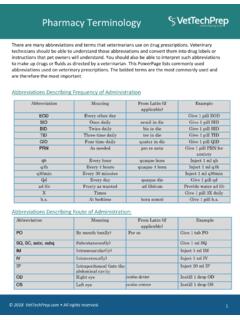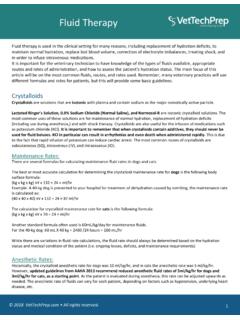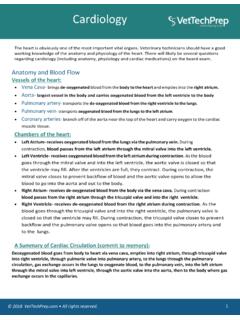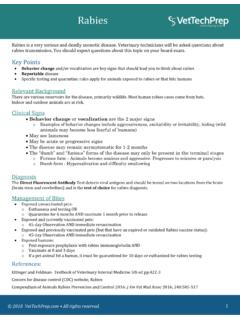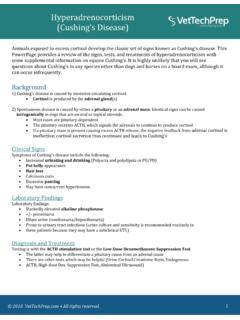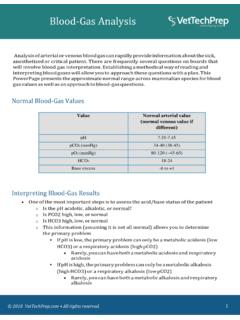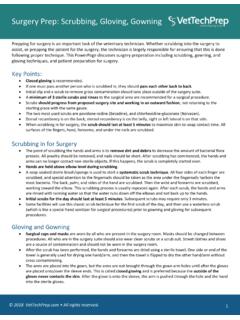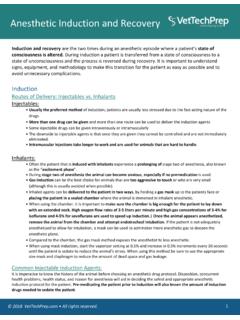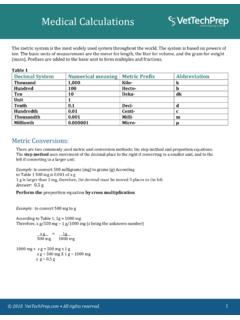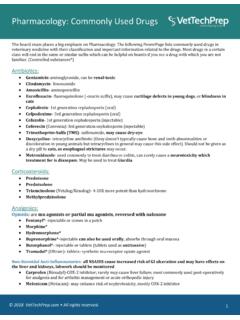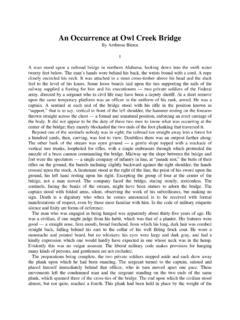Transcription of Restraint of the Dog and Cat - VetTechPrep
1 Restraint of the Dog and Cat Proper Restraint of a patient allows for the effective treatment of the patient but also the safety of the patient and the handler. Proper Restraint techniques are an absolutely vital skill for every veterinary technician. Dogs Most dogs are well behaved, well socialized family pets and can be easily handled. However, even the best trained dog may bite when he or she is painful or feels threatened. The first step towards appropriate dog Restraint is recognizing behavior cues. A Happy or Sociable Dog May: Have its head up above its shoulders Seem interested in its surroundings Wag its tail Have ears up or forward Be willing/eager to be greeted and petted Continue to follow its owner commands Make eye contact but quickly look away A Fearful or Nervous Dog May: Cower or alternately be unruly Whine or cry Shake Avoid eye contact Keep its tail tucked between its legs Hold its ears flat or back Crouch or refuse to sit Try to flee when approached Be willing to allow contact if approached slowly Refuse to make eye contact Urinate An Aggressive Dog May.
2 Have its head at shoulder level Growl or bark Hold its tail straight in-line with the spine Hold its ears up and forward Lunge or Attempt to bite when approached Have its hackles raised Challenge by making eye contact Have an aggressive posture with shoulders forward Handling Dogs Not every dog will respond in the same way to handling. Above all else, rough handling should be avoided as this may lead even a good dog to bite in an attempt to defend itself. 2018 All rights reserved. 1 When Attempting to Restrain One Should: Use the least amount of Restraint necessary for patient and staff safety Stay calm and relaxed Be firm but not aggressive Remember that even very good dogs may bite/resist if something is painful Use a muzzle for painful procedures (unless the patient has head or neck trauma)
3 , muzzles should never be left on for more than 15 minutes without giving the dog a break Avoid handling injured areas Use caution with older or arthritic dogs Attempt to comfort the animal, either through petting and/or verbal reassurance Consider having the owner leave the room as the patient may feel the need to protect their owner, become more distressed if it senses its owner's distress, also dogs may behave better without their owners present Do not allow an owner to restrain their own fearful or aggressive dog as this may lead to the owner being injured or bit Consider giving pain medication if the patient is painful or if pain is expected to be induced during a procedure Consider chemical Restraint /sedation if the patient is overly aggressive, nervous, or difficult to handle as it may be safer for both the patient and the handler Always remember that your safety is of the utmost importance Keep head above one s shoulders Restraint Tools Include: Flat leashes short leashes that have a choker type loop at one end.
4 Used to lead a dog but also as a lasso to remove a fearful/cage protective animal from a kennel Choker collars when used properly, can be an effective tool, should never be continually kept tight, should not be used in patients with neck or back pain Harnesses are very useful in small dogs or in dogs that have tracheal/ neck problems as a handle by which the dog can be controlled Muzzles should be used whenever a painful procedure is attempted or the patient has previously demonstrated aggressive or nervous behavior, can be canvas, leather or made using a flat leash or gauze, may have a calming effect on a dog E-collar very useful in brachycephalic dogs (pugs etc.) that are difficult to muzzle , will keep the mouth away from the handler Blankets/towels very useful for removing small dogs from kennels by wrapping the blanket around the animal and lifting them out Cage door can be used as a squeeze cage with extremely aggressive animals in order to sedate them, extreme caution should be used with this technique Capture pole/rabies pole should only be used in extreme cases where there is a definite danger to staff The most important Restraint tool for an aggressive or fearful dog is an experienced technician Cats Felines will not respond to the same Restraint techniques as dogs.
5 Cats tend to be more nimble and quick than dogs, more likely to be fearful in a hospital setting and bite/scratch wounds from cats are more likely to become infected. Anesthetic Machine Components 2018 All rights reserved. 2 A Happy or Sociable Cat May: Be less likely than a dog to continue to be so once brought into the hospital Walk out of a carrier and explore an exam room Vocalize but not in a distressed manner Have its head and tail up Respond positively to petting A Fearful or Nervous Cat May: Huddle in its carrier or under a towel, having to be forcible removed Yowl or Hiss Urinate or defecate in the carrier Attempt to grab or hold onto the nearest person Attempt to escape, especially if cornered Pant from stress An Aggressive Cat May.
6 Hiss, Yowl, or Scream Pin its ears back Lunge with its claws at moving objects or people Attempt to bite when picked up Try to kick with its legs when restrained Have its hackles and fur on its tail raised Swish the tail back and forth Attempt to escape, especially if cornered Pant from stress Handling Cats When Attempting to Restrain One Should: Use the least amount Restraint necessary for patient and staff safety Stay calm and relaxed Be firm but not aggressive Only attempt when all participants are ready as some cats have a limited amount of time they will tolerate handling Close all doors and windows Allow the cat to leave its cage or carrier of its own volition if possible Watch carefully for warning signs (beginning to growl, swishing the tail)
7 As unlike dogs, cats rarely attack without warning Do not allow an owner to restrain their own fearful or aggressive cat as this may lead to the owner being injured or bit Scruffing the cat by the neck is an excellent way to control the cat without hurting it Consider giving pain medication if the patient is painful or if pain is expected to be induced during a procedure Consider chemical Restraint /sedation if the patient is overtly aggressive, nervous, or difficult to handle as it may be safer for both the patient and the handler Always remember that your safety is of the utmost importance 2018 All rights reserved. 3 Restraint Tools Include.
8 Towels/blankets can be very useful in removing cats from cages, also can be used to wrap a cat to control the legs Cat Restraint bag (aka cat bag ) usually a nylon bag that a cat can be placed in to control the legs, can be difficult to initially get the cat inside, must be careful to not get fur/skin caught in the zippers Protective gloves can reduce the likelihood of a serious scratch but cat teeth are sharp enough to penetrate them, can make it more difficult to grasp the scruff of the neck , can lead to applying too much pressure due to the inability to feel the cat through the gloves Flat leashes can be used with caution when removing a cat from a lower cage Muzzles useful to prevent bites but also to cover the cat's eyes and reduce stress E-collar will keep the mouth away from the handler though because cats are more agile, they are more likely to remove them The most important Restraint tool is an experienced technician as cats are typically much more difficult to handle than dogs 2018 All rights reserved.
9 4
